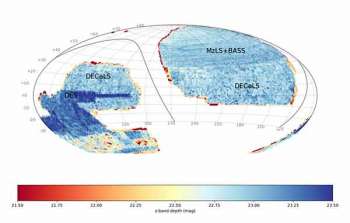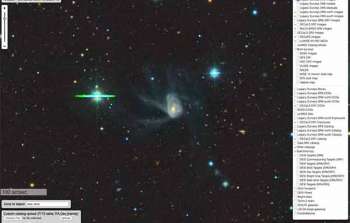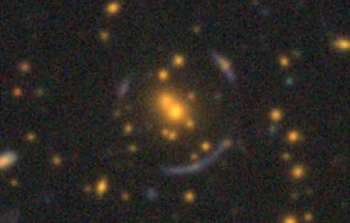sci19037 — Announcement
Data Release 8 of the Legacy Surveys
August 18, 2019
Legacy Surveys Imaging Team
The eighth data release (DR8) of the DESI Legacy Imaging Surveys is now publicly available. DR8 contains approximately 1.6 billion unique sources and includes source catalogs, images, and an interactive image viewer covering a third of the sky in three optical (g,r,z) and four mid-infrared (from WISE) bands. These data encompass the entire footprint of the upcoming Dark Energy Spectroscopic Instrument (DESI) survey and will be used for the selection of DESI spectroscopic targets. The DESI instrument is in the process of being installed on the Mayall 4-m telescope on Kitt Peak; instrument commissioning will begin in October and the science surveys will begin next year.
The Legacy Surveys combine, in a systematic way, data from the following ground-based optical surveys: (1) the Dark Energy Camera Legacy Survey (DECaLS); (2) the Mayall z-band Legacy Survey (MzLS); (3) the Beijing-Arizona Sky Survey (BASS); and (4) publicly available images from the Dark Energy Survey (DES). DECaLS and DES were conducted using the Dark Energy Camera (DECam) on the 4-m Blanco Telescope at the Cerro Tololo Inter-American Observatory in Chile. The BASS and MzLS surveys were carried out with Steward Observatory’s 90” Bok Telescope and NOAO’s 4-m Mayall Telescope at the Kitt Peak National Observatory in Arizona. In addition, DR8 contains mid-infrared photometry from 5-years worth of imaging by the WISE satellite. The DR8 grz photometry is homogeneously flux calibrated to the natural AB system of the three instrument+telescope combinations used for the surveys. The DR8 astrometry is tied to Gaia Data Release 2, resulting in astrometric residuals smaller than +/- 30 milliarcseconds.
As in previous releases, the survey can be perused using the Imagine Sky Viewer, created by team member Dr. Dustin Lang. With the Sky Viewer, users can compare the Legacy Surveys imaging with other imaging data sets (e.g., SDSS, WISE, etc.) and overlay user catalogs. A streamlined version of the viewer is available here.
An image of the z~0.44 high-redshift cluster RMJ014656-092952 from the Legacy Surveys DR8 image gallery showing the cluster galaxies and a nearly complete Einstein ring from a gravitationally-lensed background galaxy. The white scale bar represents 15 arcseconds. (Credit: Dr. John Moustakas)
DR8 also includes an image gallery, created by team member Dr. John Moustakas, of high-redshift galaxy clusters selected from the SDSS redMaPPer/v6.3 cluster catalog.
DR8 is the result of major observational and computational efforts by the Legacy Surveys team. DECaLS (PIs Drs. David Schlegel and Arjun Dey) was conducted over 196 observing nights, spread over 248 calendar nights between August 2014 and March 2019. Fifty-seven observers from 22 institutions took part in the observing campaign. MzLS (PI Dr. Arjun Dey) was carried out over 398 nights spread over 428 calendar nights between April 2015 and February 2018. Ninety-one observers from 34 institutions took part in the observing campaign. BASS (PIs Drs. Xu Zhou and Xiaohui Fan) was conducted over 335 nights spread over 387 calendar nights between January 2015 and March 2019. Thirty observers from 9 institutions took part in the observing campaign. The data were processed at the National Optical Astronomy Observatory in Tucson, Arizona and the National Energy Research Scientific Computing Center in Berkeley, California.
An overview of the full DESI imaging effort is provided in Dey et al. (2019). The DR8 data products are available through [1] the Legacy Survey website; [2] the NOAO Science Archive; and [3] the NOAO Data Lab. The NOAO Science Archive provides access to both the DR8 raw and calibrated images. The NOAO Data Lab provides tools to access databases containing the catalogs. The Data Lab tools enable complex user queries and analyses of the data using a Jupyter Notebook server, a Simple Image Access (SIA) service and a TAP handle (which allows, for example, users to connect to the databases via tools such as TOPCAT). Example Jupyter Notebooks are also provided. Data Lab also provides opportunities for combined analyses using other datasets (such as Dark Energy Survey (DES) DR1, the NOAO Source Catalog (NSC), and Gaia DR2). Precomputed tables that crossmatch Legacy Surveys to other catalogs are provided by Data Lab for these purposes. User feedback can be communicated via the Data Lab Helpdesk or email (datalab@noao.edu). A comprehensive list of Legacy Surveys acknowledgments is available from Data Lab.
The Legacy Surveys Imaging Team is: Stephen Bailey, Arjun Dey, David Herrera, Stephanie Juneau, Martin Landriau, Dustin Lang, Aaron Meisner, John Moustakas, Adam Myers, Eddie Schlafly, David Schlegel, Frank Valdes, Benjamin Weaver, Christophe Yeche, and Mark Zhang
About the Announcement
| Id: |
ID
sci19037
|


